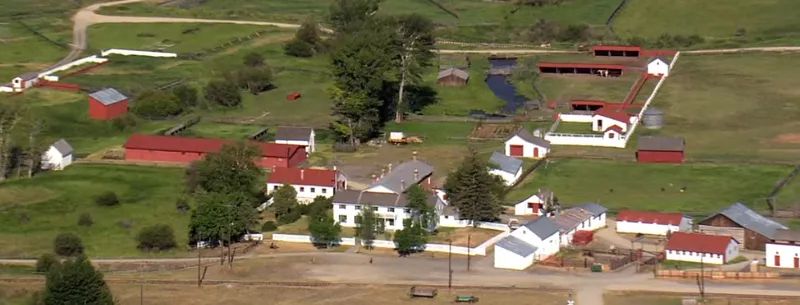
2008 MONTANA COWBOY HALL OF FAME INDUCTEE
1860 – 1920 LEGACY AWARD DISTRICT 10
Grant Kohrs Ranch (Est. 1862)
Montana’s Grant-Kohrs Ranch was established by John Francis "Johnny" Grant, a Canadian fur trader, and expanded by Conrad Kohrs, a Montana cattle baron. Located near Deer Lodge in Powell County, the ranch was designated as a National Historic Landmark on December 19, 1960, to commemorate the Western cattle industry. The current park, created in 1972, is maintained as a working ranch by the National Park Service.
Johnny Grant was born at Fort Edmonton, Alberta, Canada in 1831. At age seventeen he joined his father at the trading post Fort Hall, Idaho Territory. The fur trade was his heritage but not his future. He left his father's household in 1850, and settled nearby, marrying a Shoshone woman. His complex family tree eventually numbered twenty-one children by eight different mothers. Grant traveled the Northwest and married women from several different tribes. Throughout his long life he kept his large family – which also included other adopted, abused and abandoned children he encountered in his travels – close by.
During the 1850s, the Oregon Trail generated an active trade in horses and cows. Traders could barter one fit animal for two trail-weary ones. These livestock were rested and restored in the lush grasslands of Idaho and southwest Montana, then resold come spring. After successfully wintering just this sort of stock in the Deer Lodge Valley in 1857, Grant returned to Montana in 1859, and built a home. Until Montana's gold boom arrived, he found a market for his livestock in the mining camps of Idaho and California.
In 1862, Grant began building the large house that is the core of today’s Grant-Kohrs ranch. He lived there with his Bannock Indian wife, Quarra. Grant wrote with pride that she spoke French, English and several Indian languages. He also stated that she made "very nice butter" and could ride rough horses.
Part of Grant’s new house would serve as a trading post. A flood of gold miners were entering southwest Montana, and Grant did his best to accommodate them by opening a livery stable, saloon, blacksmith shop, sawmill, flour mill and other businesses. He saw little success with these businesses; educated in French, Grant often found himself at a disadvantage when business contracts were written in English by dishonest men.
Grant decided to return to Canada. He sold his ranch to Conrad Kohrs in 1866, and left his family for several months while he searched for a place to settle north of the border. When he returned to Deer Lodge, he found that Quarra had died of tuberculosis. Gathering his remaining family, he left with a party of 200 Metis. Whether he knew it or not, Grant had successfully established the livestock industry in Montana during his short stay. After 20 years in the Red River Country, Grant moved to the Edmonton area of Alberta, where he died in 1907, within sight of the Hudson Bay Post where he had been born 76 years earlier.
Carsten Conrad Kohrs, a 27-year-old German immigrant, arrived in Montana Territory in 1862 in search of gold. He discovered that the only people who were getting rich were the people who were accommodating the miners. Kohrs became a butcher, but lacked beef; thus he began raising his own cattle. In 1865 he offered Johnny Grant $30,000 for what is now known as the Grant-Kohrs National Historic Site. Grant initially refused, but was eager to sell the next year; thus Kohrs bartered him down to $19,200 for the land, herds, buildings and equipment.
After the purchase, Kohrs invested in mining, real estate and water rights, while his half-brother and partner John Bielenberg did the ranch work. Kohrs' diversity proved crucial after the hard winter of 1886-’87, as most of his open range cattle died. Only one herd of purebred Shorthorn bulls survived in the slightly warmer conditions of the Deer Lodge Valley.
With a Shorthorn herd , his profits from other ventures and a $1 million loan from a Butte bank, Kohrs began buying the remnants of numerous bankrupt cattle operations. By 1890, he repaid the loan, recovered his losses and added a swanky brick addition to the ranch house. According to a list of Montana’s 100 most influential early-day citizens published in the Missoulian, this cattle baron at the peak of his success managed a 10-million-acre cattle empire that spanned four states and shipped 10,000 head of cattle annually to the Chicago stockyards, earning Kohrs the nickname "Montana's Cattle King." Kohrs also played an important role in Montana's history by serving as a territorial and state senator and as a leader of the Montana Stockgrowers Association.
In 1918, Kohrs sold all but the Deer Lodge property, where he lived with his wife and two surviving daughters until his death in 1920.
According to government archives, Conrad Kohrs Jr. – Carsten Conrad Kohrs’ grandson – sold the ranch to the National Park System in 1972. The United States Park Service preserves the historic ranch to interpret the significance of the nation's frontier cattle era. Cattle still graze there as they have for more than 150 years. The 1,500-acre park/ranch includes 90 structures, 26,000 artifacts and 100 shelved feet of business records kept since Kohrs acquired the ranch in 1866.

